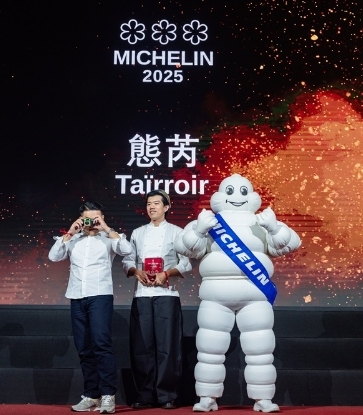Chefs Richie Lin of MICHELIN-listed MUME – which recently celebrated its 10th anniversary – and Zaiyu Hasegawa of two-MICHELIN-starred and MICHELIN Green-starred Den in Tokyo have known each other for more than a decade. Fast friends, they share that they not only enjoyed each others’ cooking but also held very similar views on how to lead a team, what kind of atmosphere to create in a restaurant and how to treat their guests.
"It was fate," says Hasewaga, describing their connection. “Fate and chemistry,” agrees Lin.
RELATED: MUME Chef Richie Lin Reveals Plans for the New Post-Pandemic F&B Scene

The pair have not only dined at each other’s restaurants numerous times, but have also participated in various cooking collaborations in their hometowns and overseas together. This most recent trip, however, stands out as a rare experience for both. This time, it was an exploratory trip designed by Lin to Tainan and Kaohsiung for Hasegawa to rediscover Taiwan. The two visited iconic attractions in Tainan and Kaohsiung, tasting local delicacies and exploring the regional cuisines and culture from the perspective of chefs.
The mission: to decode the Taiwanese texture of Q. A term originating in Taiwan, Q is the word used to describe the chewy sensation of pearls in milk tea, elastic noodles, bouncy fish balls and the soft bite of glutinous rice balls. QQ, for added emphasis, describes the joyful texture of something satisfyingly chewy and elastic, similar to “mochi mochi” in Japanese, or “al dente” in Italian. The onomatopoeia is easy to understand and captures the essence of many Taiwanese delicacies and the Taiwanese pursuit of taste.
RELATED: The Best Places for Dry Noodles According to the MICHELIN Guide Taipei & Taichung

The first stop is Unchun Noodles in Xigang, Tainan. Founded in 1921, the establishment has been passed down two generations to its current owner Lee Ching-hui. The simple, yet time-honoured noodle-making method starts with mixing high-quality patent flour and water, and then kneading and pressing the dough in a 12-step process before the dough is thrown and stretched by hand, the noodles then folded and arranged neatly to be sun-dried naturally. From the ratio of flour to water to the weather affecting the moisture content of the noodles, this knowledge and experience handed down through the generations are the keys to the prized QQ of the noodles.
RELATED: Must-try MICHELIN-recommended Eats Near Tainan Art Museum

Next, the chefs head to Tainan’s Bib Gourmand eatery, Yuan Zai Hui (Guohua Street), yet another storied establishment passed down through three generations. Specialising in shaved ice desserts, the shop offers more than a dozen toppings for customers to mix and match. Almost all the toppings are made fresh at the store every day, including their signature glutinous rice balls. Overseeing the process is Chang Hsiu-mei, who explains how a certain proportion of old and new as well as pointed and rounded glutinous rice varieties are ground together and then mixed with water to form the rice flour. Everything is taken into consideration from the condition of the rice to the weather, and adjustments are made along the way to achieve the perfect Q texture.

Finally, the chefs visit Good Meet Fish Ball located in Guomin Market in Kaohsiung. Its owner, Shen Kun-shan, started learning how to make fish balls at the age of 16 and has since garnered over 50 years of experience. Not only are the fish balls made from the freshest ingredients, they are frozen immediately after they are formed to preserve their taste and texture. For Shen, the devil is in the details. For example, the cuttlefish used for the cuttlefish balls are meticulously cleaned and prepared to make sure all bones are carefully removed and the water drained; bamboo shoots are washed and blanched before they are made into bamboo shoot balls to remove its bitter taste, while fish paste is left to rest overnight to remove excess moisture and ensure its QQ bounce.
RELATED: MICHELIN-Recommended Eats Along the Kaohsiung Metro Line

With all the insight gleaned along the way, the duo came together in the kitchen of one-MICHELIN-starred Sho in Kaohsiung to create a dish inspired by their new understanding of Q. Head chef of Sho, Fujimoto Shoiji, was Hasegawa’s former sous chef in Japan before being appointed to helm the restaurant in Taiwan. It gained its one-star accolade in 2022, having become known for marrying the essence and elegance of Den’s cuisine with its own unique local spin.
RELATED: Aiyu Jelly: Taiwan’s World-class Ingredient of Limitless Possibilities
Borrowing the iron pot used to make Den and Sho’s signature Kamameshi dish, Lin and Hasegawa cook premium Japanese Nikomaru rice with seasonal bamboo shoots for a fluffy, fragrant effect. Taking inspiration from Taiwanese braised pork rice, the chefs replace pork belly with braised pig’s ears to create a Q version of the beloved dish, slick, gelatinous and rich.

This elevated take on the classic Taiwanese braised pork rice showcases both the best of Taiwan and Japan, exemplifying the unique Taiwanese pursuit of QQ deliciousness.
RELATED: Eat Like A Chef: Explore Kaohsiung with chef Andre Chiang of RAW and chef Ricardo Chaneton of MONO


















